the music of the trio. free for download, name your price.
https://orphansoundsystem.bandcamp.com/releases
Welcome to Meet The System by Orphan Sound System aka OSS. We are making a map from where we started out. Our sonogeography is diverse and this album recorded in the garage in Williamsburg just one of many artefacts from a very dense 2 years of creative activity. We pass the microphone to John El-Manahi, who recalls our formation in 1994 (years are often contested) in Firenze, Italia.
"It’s my recollection that OSS was formed the moment John Palumbo knocked
on the door of the flat I was sharing with Jeff Gburek, Florence Italy,
1993, and said “I heard the Monk and had to see where it was coming
from.” From that moment we had music as the foundation of our
interaction. Gburek and I had met the year before in similar fashion
when I’d heard the sounds of an acoustic guitar in some alt tuning
echoing in the stairway of a temporary student lodging...I eventually
found him and said something dumb about Paco Del Lucia or John
McLaughlin. Eventually that awkwardness gave way to cautious, suspicious
friendship that solidified over travels, sharing music, philosophical
discussions, art and poetics.
By the time Palumbo had come to Italy, we’d already been flatmates
binging on Scelsi, Xenakis, Bartok, Ligeti, NanCarrow, Messian, Henze,
Boulez, Stockhausen, Beethoven etc....Mingus, Monk, Miles, Coltrane, Sun
Ra, Albert Ayler, Throbbing Gristle, Neubauten,
Can, Sun City Girls...Umm Kalthoum, Gnawa Music, Nass El Ghiwane
Turkish Pop, Balinese and Javanese Gamelan, Sundanese Pop, Tibetan
Monks, African Music of Pygmy, Bantu, and Tanzanian Peoples, Nigerian
Beat...to name a few. The point is that we were immersing ourselves into
a sonic universe that was completely interconnected. We listened with
the intent of tying music to our current state of being as a means of
expressing all our creative and spiritual energy. Along with all the
sound were books, poetry, mythology, film, art, philosophy and world
religions. Everything was included in our understanding of sound as a
means of expression and transformation. Palumbo came in from a primarily
Jazz, punk background...but shared the improvisational sensibility that
our listening was unconsciously developing. We were aligned with the
sensibilities of Sun Ra, Cage, Kurt Schwitters, and other transcendental
Jazz musicians.
After Italy we met up in
Williamsburg, Brooklyn in 1995. We were a cobbled together unit that had
some pretty ramshackle instruments and amps...I believe we were very
lucky to have landed in such musical poverty because it forced us to be
inventive with what we had. Create instruments and sounds from tuning,
preparing, found objects, and invention. I did not own or use a single
pedal during my entire time with OSS. I simulated echo, and pitch shifts
by adjusting my playing style to mimic the sound I wanted to make. I
added shortwave radio and a hand held tape recorder that I would play
through the guitar pickups.
The whole band only had one or 2 pedals that Gburek cooped to make the
“Lancelot”. It was a microphone jammed into the horn of a discarded
bugle, run through a pitch shifter, that had a looping setting. In
addition to it being a feedback wand it was a listening instrument that
took all the sounds we made and transformed them. The feedback sounds
were completely unique. At times the Lancelot would just run on auto
pilot while Jeff played another instrument. It’s in these moments that
OSS produced more sound than seemed possible for 3 people.
*** see Jeff's note below
Palumbo was always an inventor. He
tried to make a “drum machine” that would allow him to play far more
drums than he would be able to by hand. It was a massive wood and cable
contraption that was far too big to move and kinda dangerous if you got
too close to it. As it was he had saw blades, metal pipes and plates,
shards of cymbals, and assorted other pieces that could be used as
percussion. They were hanging all around his drum kit within reach of
Jeff and I. Our extensive metallic percussion was another facet of OSS’s
texture. I’d found an old metal fireplace and attached a metal comb to
it. That became the “4th Orphan”...an instrument that could sound like
anything from a timpani to a toy piano. We would play any of these at
will so we could shift textures seamlessly.
This is all to explain how the music of OSS began to form and evolve in
the moment due to the sounds we had available. Playing bass or guitar or
drums was a given, but we wanted to compose pieces, or create an
ecstatic event like the folkloric music of indigenous people. We didn’t
care if we were virtuosic on an instrument. It was more the sound and
timing of it that made any difference. Palumbo using clarinet, or
trombone on the moments he was inspired to, provided far more impact
than an overly cerebral academic choice. Everything was drawn out of the
ether and we were just along for the ride.
We’d made attempts to be more
purposeful even as an improvisation group. There’s a certain amount of
snottiness and elitist mentality in the circles of avant-garde and
experimental music. We were fully confronted by this, even though we had
studied music composition in college and we had all been very
experienced players. It didn’t matter. In those circles your pedigree
has to pass the sniff test, like dogs smelling each other’s asses. In
response we created improvisation maps and notation for scoring so we
could be more deliberate in the process. We developed things like “non
playing” where we would frenetically mimic playing as close to our
instruments and hit by chance. What resulted was heavily textured quiet
moments with percussive exclamations, which would emerge with greater
frequency. Also, we would create shapes that had wave like forms with
markings like crescendo, decrescendo, accelerando, ritardando, staccato,
legato etc. and we could map out a flow based on visual information. We
all had visual art backgrounds so we used these maps and waveforms to
create loose scores that allowed us to adhere to a “composition”.
Ultimately we internalized all these methods and used them in a seamless
non verbal communication based solely on aligned intuition. Basically
we stopped seeking approval from academics and followed our creative
instincts. What we were producing was like nothing we’d ever heard so we
felt we were on the right path.
The gigs were a mixed bag. The climate was accepting enough for noise
and improvisation bands in NY at that time. Though there was still the
arms folded audiences who were too uptight to go anywhere. The exception
were loft parties and squats that had a more informal vibe. These
people we’re looking for freakish acts that would give their events a
legit art vibe. So we had some very good performances that were well
received.
The resurfacing of these
recordings are a time capsule from that pre-internet period of
experimentation and free thinking. Alternative methods of production and
disseminating ideas. The tapes that have survived are almost entirely
live and created in the moment. If one were to play them in order they
would see a clear evolution of technique and complexity of idea."
Note on The Lancelot by Jeff Gburek
The Lancelot was named so because once the microphone was inserted into
the bell of the bugle it resembled a medieval lance. The canalization of
the soundwaves lead to a peculiar effect: it would create a feedback
pitch entirely dependent on what area of the speaker of the amplifier it
was aimed at and the physics of this made it predictable and playable.
It seems to be the fore-runner of microphone/saxophone feedback
arrangements I would later see used by John Butcher & others. The
Lancelot was also therefore a wind instrument, a kind of electro-acoustic kazoo and with
the pitch-modulator and delay pedal it was capable of becoming a
cybernetic system interactive with the entire sonic environment. Once I
started working with Djalma Primordial Science, I started to call it the
Orphan's Ear. The Lancelot was a device that both listened/received and
transmitted/generated sounds.The search for automatons as John
indicated would not stop there. As we continue to re-master and upload the surprises will continue.

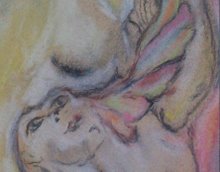



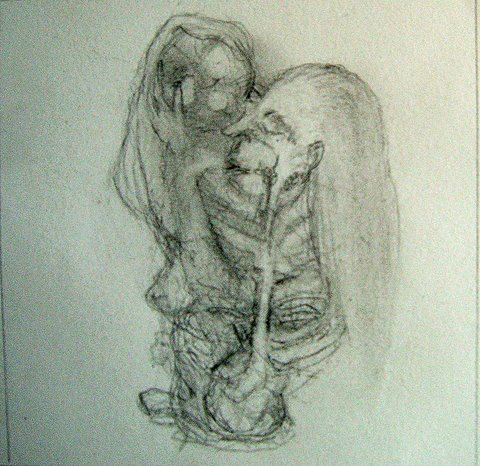
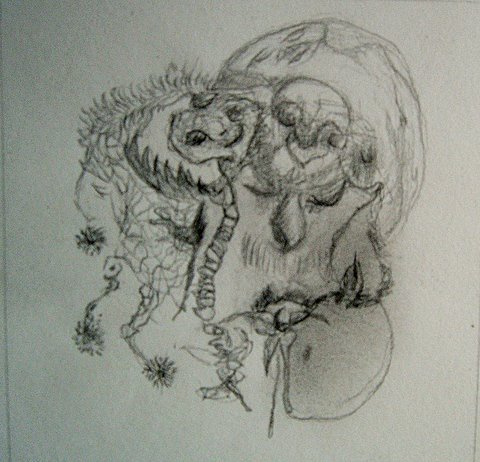
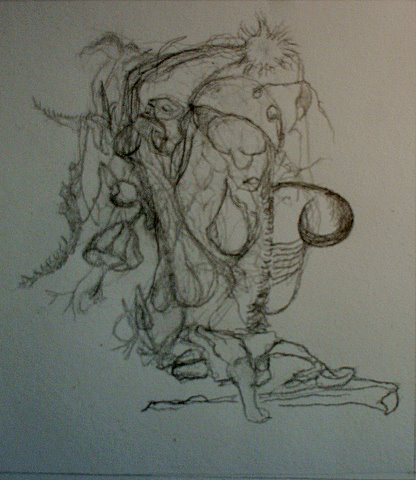
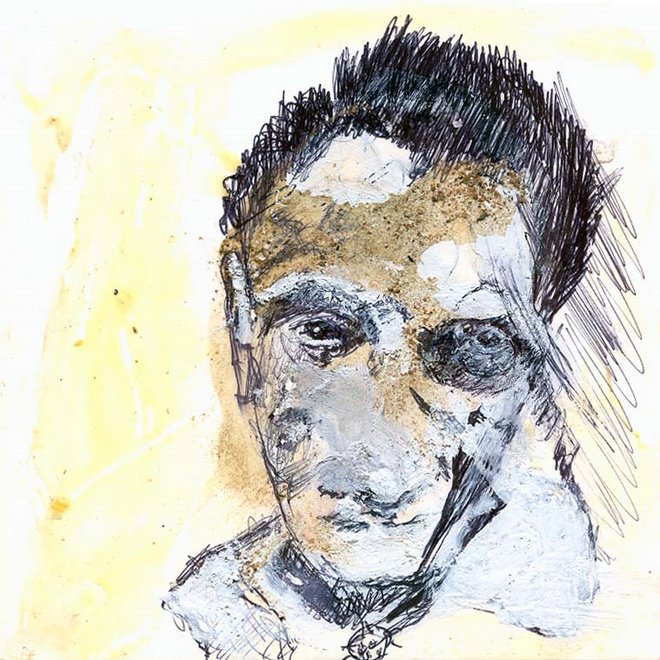
No comments:
Post a Comment